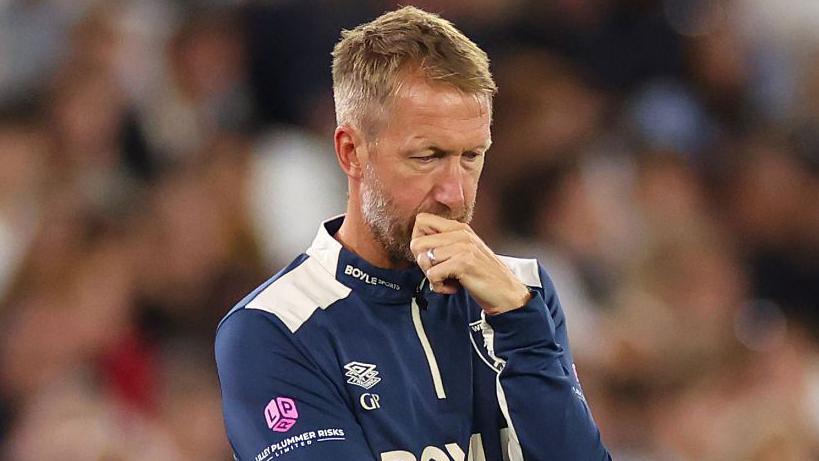In the dampened aftermath of West Ham’s Carabao Cup exit to Wolves, captain Jarrod Bowen’s heated exchange with a supporter encapsulated a club in turmoil. Three consecutive defeats, 11 goals conceded, zero points on the Premier League board – this dismal opening paints an alarming picture for a team once buoyed by European glory. As former midfielder Nigel Reo-Coker starkly summarized: It’s very bleak. But how did a club celebrating continental silverware just 14 months ago descend into crisis? The roots of West Ham’s struggles run deeper than any single issue, weaving together managerial uncertainty, recruitment missteps, and systemic decline.
Anatomy of the West Ham Crisis: A Statistical Nightmare
The numbers confronting Graham Potter are damning. Since his appointment on January 14th, West Ham would sit bottom of a hypothetical Premier League table comprising ever-present clubs during that span. Their 25% win rate across 20 league matches ranks as the second-worst in club history among managers with equivalent tenure, trailing only Avram Grant’s ill-fated reign. Defensive fragility underpins this collapse – only Tottenham and Brighton have conceded more since Potter’s arrival, while this season’s 12 shots on target faced per game tops the division. Most concerningly, the Hammers have hemorrhaged 15 points from winning positions under the former Brighton boss, revealing a chronic inability to manage games.
Transfer Market Failures Haunt Irons
West Ham’s summer business typifies their muddled strategy. Despite earning £105m from Declan Rice’s sale and £55m from Mohammed Kudus’ departure, their recruitment has exacerbated rather than solved weaknesses. The failure to replace Rice’s midfield dominance has proven catastrophic – Nigel Reo-Coker’s critique on BBC Radio 5 Live resonates loudly: They have no legs or dogs of war to win the ball back. They look weak. While promising additions like El Hadji Malick Diouf and Mads Hermansen arrived, critical gaps persist. No specialist defensive midfielder joined despite public assurances, while the attack remains overly reliant on Bowen’s output. These omissions reflect a broader institutional failing – a club without cohesive recruitment vision since former technical director Tim Steidten’s abrupt departure last February.
Post-Europe Hangover Turns Toxic
The Prague Paradox – West Ham’s 2023 Europa Conference League triumph – inadvertently accelerated their decline. Owner David Sullivan’s immediate confirmation of Rice’s departure destabilized the squad, while the initial £140m reinvestment underwhelmed. James Ward-Prowse’s early promise faded, Konstantinos Mavropanos proved error-prone, and Kalvin Phillips’ loan spell became a cautionary tale. This summer’s £55m Kudus sale to Spurs reinforced perceptions of West Ham as a selling club, despite Sullivan’s European ambitions. As Potter navigates this inherited malaise, he lacks the midfield anchor (Rice) and creative spark (Kudus) that previously papered over cracks. The consequence? A disjointed squad still leaning on 30-somethings Lucas Paqueta and Tomás Soucek while younger signings stagnate.
Potter’s Tactical Tightrope Walk
Critics question whether Potter’s tactics compound structural weaknesses. His persistence with a back-three system exposes Nayef Aguerd’s lack of recovery pace and leaves fullbacks overwhelmed – evidenced by Wolves’ wingers running riot in midweek. The midfield double-pivot of Soucek and James Ward-Prowse lacks mobility, creating cavernous gaps opponents ruthlessly exploit. While the 4-0 opening day loss to Manchester City carried mitigation, surrendering 4-1 leads against Brentford and 3-0 advantages at Brighton revealed alarming game-management flaws. Potter’s public calm contrasts with Reo-Coker’s observation: When cameras panned to him, he looked like he had no idea what to do. With fans chanting former manager David Moyes’ name during the Brentford collapse, the 49-year-old’s reputation as a progressive coach faces its sternest test.
The Escape Route: Transfers or Turmoil?
West Ham’s hierarchy now faces a defining fortnight. The squad requires urgent midfield reinforcements before the transfer deadline, ideally a physical enforcer and creative technician. Potter needs tools to implement his possession-based system properly – staring at Sofyan Amrabat and Ibrahim Sangaré represents their best hopes. Defensive upgrades also loom essential, with Arsenal’s Rob Holding and Chelsea’s Trevoh Chalobah linked. However, Financial Fair Play constraints limit maneuverability, necessitating sales before signings. Failure to strengthen risks transforming early-season anxiety into full-blown crisis, particularly with daunting fixtures against Liverpool and Newcastle looming post-international break.
Verdict: Relegation Battle Inevitable Without Change
Historical precedents offer little comfort. This 11-goal concession marks West Ham’s worst defensive start since 1954/55 – a season culminating in relegation. While Potter previously demonstrated crisis-management credentials during his Brighton tenure, this challenge appears more profound. The squad’s aging core demands transition, but recruitment failures have blocked evolution. Unless new signings provide immediate quality injections, the London Stadium appears destined for a season-long relegation dogfight. As protests brewed during Wednesday’s cup exit, the board must realize their entire project hangs in the balance – they’ve gambled on outscoring problems rather than solving them. For Potter, September’s fixtures against Nottingham Forest and Everton have become career-defining. Anything less than four points from those matches could trigger irreversible discord.
